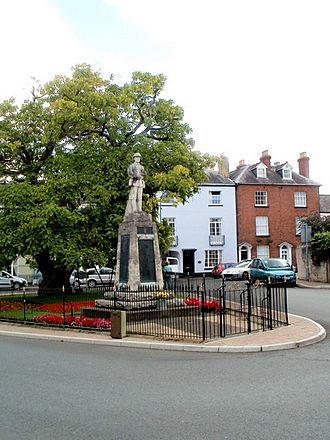The Indian Bean Tree, St James Square, Monmouth facts for kids
Quick facts for kids The Indian Bean Tree |
|
|---|---|

|
|
| Alternative names | Catalpa bignonioides |
| General information | |
| Address | St James Square |
| Town or city | Monmouth |
| Country | Wales |
| Coordinates | 51°48′47″N 2°42′40″W / 51.813034°N 2.711059°W |
The Indian Bean Tree in St James Square, Monmouth, Wales, is a very old and special tree. It is also known as Catalpa bignonioides. This type of tree originally comes from the southeastern United States. It was planted in the square around the year 1900.
In 1921, the Monmouth War Memorial was built next to the tree. For over 100 years, the tree has been a landmark in the square. In 2005, the Monmouthshire County Council decided the tree should be cut down. Many people in the community were very upset about this. After much discussion, a solution was found in 2006. The tree received special care, and by 2011, it was growing well again.
A Century of Growth: The Indian Bean Tree's History
The Indian Bean Tree was planted in St James Square in Monmouth around 1900. It is a type of tree called Catalpa bignonioides. These trees are originally from the southeastern United States. When the Monmouth War Memorial was unveiled in 1921, the Catalpa was already a large, mature tree.
In 1946, a special rod was put in place to help support the tree's main branches. Many people believe this Indian Bean Tree is one of the best examples of its kind in Britain. It is also thought to be one of the oldest and largest Catalpa trees in the entire United Kingdom. The tree stands behind the war memorial, surrounded by grass and flowers. The memorial, tree, and garden area are all enclosed by railings.
Saving the Tree: A Community Effort
In January 2006, a man named Stephen Clarke spoke to the Monmouth Town Council. He shared a new report about the Catalpa tree from an expert named Jerry Ross. Ross believed that even though the tree was not perfectly healthy, it was "far from dying." Clarke explained that this was the third expert opinion. The first expert was hired by community groups, and the second by the Monmouthshire County Council.
Clarke told the town council that the county council had not accepted the newest report. He also mentioned that he and the head of the county council disagreed about the tree's health. They also disagreed about how many letters and messages people had sent to support the tree. Clarke suggested getting another expert opinion. Since the county council still wanted to cut down the tree, Clarke asked lawyers to look into legal action. People even sold pictures of the tree to raise money to save it.
In February 2006, community groups arranged for a fourth expert, an arborist named David Lonsdale, to check the tree. An arborist is someone who specializes in trees. Lonsdale said that any danger from the tree could be reduced in two ways: by trimming the top branches and by supporting the main branches. He shared his findings with the Monmouthshire County Council.
The Indian Bean Tree in St James Square was very important because of its size and age. Lonsdale believed that the tree was valuable enough to spend money on its care. He also suggested using the money that was planned for cutting down the old tree to pay for its treatment instead. He warned that the tree's health would eventually get worse, even with treatment.
A Happy Ending: The Tree's Recovery
The fourth expert's report about the Catalpa tree was well-received by the Monmouthshire County Council. The council worked with the Monmouth Town Council and the Monmouth Action Group to arrange for the tree's care. Treatment began, including trimming the top of the tree and general pruning. This work was finished by April 2006.
Temporary cables were also put in place to support and strengthen the tree. They looked into getting permanent supports, which would cost money. Later, metal supports were installed under some of the tree's large branches.
Interestingly, people suspected that a local man named John "Mad Jack" Roocroft was involved in something unusual. He was known for not always following rules. One day, a large branch that hung over the street from the Indian Bean Tree suddenly disappeared. Even though there was no proof, many believed it was "Mad Jack" and his red tractor that were seen leaving the square with parts of the branch. Some people think that his removal of this big branch actually helped the Catalpa tree recover.

